New plans for Brisbane metro revealed
A YEAR on from the introduction of plans for a Brisbane Metro, questions are still being asked about what exactly the billion-dollar project means. We take a look at what has been revealed so far.

Local
Don't miss out on the headlines from Local. Followed categories will be added to My News.
MORE than 12 months on from the introduction of plans for a Brisbane Metro and questions are still being asked about what exactly the billion dollar project is. As the completion of the business case creeps closer Quest News takes a look at what has been revealed so far.
THE PAST
The concept of a Brisbane Metro was first introduced during the 2016 Brisbane City Council election.
In January 2016 Lord Mayor Graham Quirk revealed his first election commitment — plans for a $1.52 billion underground metro system to run through the CBD between Woolloongabba and Herston.
At the time Cr Quirk said the rubber-tyred system would remove 200 buses an hour in the morning peak from Victoria Bridge and carry up to 30,000 passengers an hour.
Labor Lord Mayoral Candidate Rod Harding argued Cr Quirk’s unfunded proposal was the wrong approach having earlier launched his own light rail plan for the city.
Labor’s proposal was to use light rail to link the CBD to South Bank, Fortitude Valley, Newstead West End and the University of Queensland.
Cr Quirk won the race for Lord Mayor at the 2016 election and said he was confident the $1.54 billion Metro project would go ahead.
Work on the business case started in May, 2016 and was to continue for 12 months.
Last September Infrastructure and Planning Minister Jackie Trad rejected the use of the Go Print site for Brisbane Metro, and it became apparent the proposal would require a significant redesign.
Later that month Cr Quirk announced he would turn to residents for help with developing the business case.
From August to November last year, 1489 residents provided 1066 pieces of feedback.

THE PRESENT
On Saturday the council revealed a drastically revised plan for the metro system.
There are now two lines included with significantly expanded routes and more than $500 million cut from the initially proposed project cost.
One service is now planned to run from the CBD’s Roma Street Transit Centre to Eight Mile Plains in the city’s south, mostly along the southeast busway.
A second high-frequency line has been designed to run from the Royal Brisbane and Women’s Hospital to the University of Queensland Lakes in the west, using parts of the State Government controlled northern and southeast busways.

The revised plans proposed the use of “bi-articulated” buses, which are commonly known as banana buses.
At today’s Active and Public Transport Committee Opposition transport spokesman Jared Cassidy asked the committee’s chairman Adrian Schrinner if “bendy buses” were the final option or if other options would be considered.
Cr Schrinner said the council would not be doing any further analysis of other options.
“We have selected this as our preferred option,” he said.
Cr Schrinner said the revised proposal is a 21km route that is not limited by tracks.
The proposed system can run on the existing busway and can also be used on roads, however it is proposed the 60 services would be contained to existing busways.
Cr Schrinner said the city’s priority was to provide high frequency, high capacity services.
“The reality is proposing that some services will be truncated ... other services will continue to operate,” he said.
“If you fast forward maybe a few years down the track there will be more and more metro services provided and fewer bus services on the route.
“Over time metro services would replace general bus services.”
Cr Schrinner said the council was still exploring different examples of vehicles for the Brisbane Metro, and did not rule out having vehicles purpose-built.
THE FUTURE
Now that the revised Brisbane Metro project has been announced the council will respond to key community and stakeholder concerns.
Further community consultation is planned for April, 2017 and will include community information sessions and stakeholder meetings.
The feedback will inform the preliminary business case which will be finalised in May 2017.


